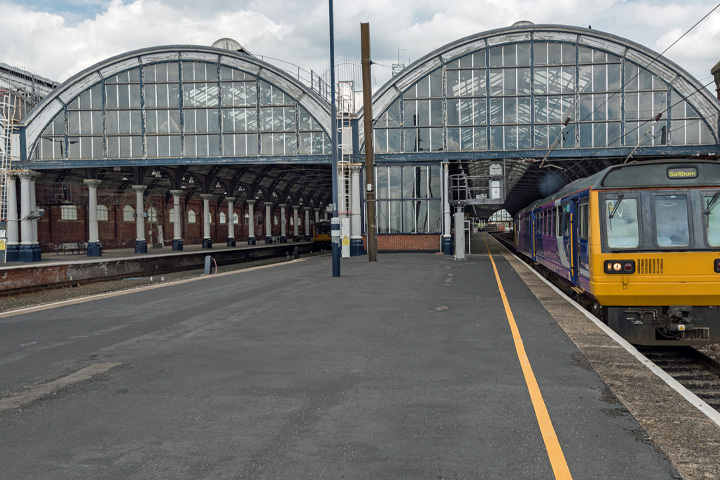Your Move Darlington Local Area Guide
Why move to Darlington?
The market town of Darlington lies in the Tees Valley in the north east of England. Crowned by the clock tower and brimming with historic buildings, the town comes with a distinctive Victorian flavour. But, at the same time, it's a town that's undergoing extensive restoration and redevelopment.

Darlington has handy train and road links, connecting it to major cities as well as the wild countryside of the nearby North Yorkshire, Yorkshire Dales and Lake District national parks and North Pennines Area of Outstanding Natural Beauty. Also last year, uSwitch crowned Darlington the seventh best place to live in the UK.
Darlington is well connected when it comes to transport links. As befits the birthplace of passenger railways, it is on the main East Coat Train line, 30 minutes/every 15-20 minutes to Newcastle; London, two hours 40 minutes/half-hourly; two and a quarter hours/half-hourly to Edinburgh. The A1's just outside, with junctions north and south of the town, and Durham Tees Valley airport's about a 20-minute drive.
Unlike many towns, Darlington’s centre has its own distinctive look. The Victorian market hall, theatres, narrow streets of the wynds and yards, which are filled with independent shops and cafés, all hint to its past. The centre is nearly all pedestrianised, which makes moving between the shopping centres, bars and restaurants hassle-free.
Large-scale restoration work has helped to bring many areas back to their Victorian heyday. South Park has been fully restored and the Civic Theatre is currently undergoing restoration. New areas are also being developed. A former bus depot is set to be transformed with a new multiplex cinema, hotel and restaurants. Central Park is bringing hundreds of new homes to the area, as well as a college campus and a campus for Teesside University.

Average property price in Darlington

Average rental price in Darlington
Transport in Darlington
Darlington train station has direct services to Edinburgh Waverley, Leeds City, London King’s Cross, Manchester Airport, Manchester Piccadilly, Newcastle, Plymouth and Southampton. You can be in London in two and a half hours, while a journey to Newcastle takes just 30 minutes.
You can also access the Tees Valley line, which connects all the main settlements of the Tees Valley, such as Saltburn and Bishop Auckland.
There are excellent road connections in and around Darlington. The town is served by three junctions of the A1(M), which bypasses Darlington to the west, and you can easily access the A66, which connects to Stockton-on-Tees and the A19.
Durham Tees Valley Airport has three daily flights to Amsterdam, where you can connect to other international flights. Throughout the week there are also flights to Aberdeen, Luton and Humberside. International destinations are currently being added.
For more international and domestic destinations, head to the nearby airports of Newcastle and Leeds Bradford.
History in Darlington
Uncover Darlington’s role in the history of the railway at Head of Steam railway museum. It’s set on the route of the 1825 railway and reveals the role the Stockton and Darlington railway played in steam travel. Exhibits include Stephenson’s ‘Locomotion No.1’, which is one of the oldest surviving steam engines in the world as well as the first steam train to carry fare-paying passengers.
Learn about how the Victorian authorities supplied the town with water at the Tees Cottage Pumping Station. It has two original pumping engines that are put into action on four weekends a year. You can also watch live demonstrations of the old trade of blacksmithing at the Blacksmith’s Shop.
St Cuthbert’s Church stands out thanks to its medieval architecture. It was completed in 1240 and marks the site of one of the temporary resting places of St Cuthbert after the Vikings attacked Lindisfarne.
Darlington culture
Musicals, plays, dramas and pantomimes are all performed on the stage of the Civic Theatre, which opened in 1907. It’s currently being renovated and re-opens as the Darlington Hippodrome in 2017.
The Forum serves as a meeting place for musicians as well as a comedy club and film club. The popular R‘n’B Club books local acts and touring bands – make sure you keep an eye on the events calendar to see what’s coming up.
Professional and amateur productions are hosted in the Art Deco Majestic Theatre. Visit to see comedy, drama, music, dance and film, or sit and enjoy a drink in the bar and lounge.
Outdoors in Darlington
South Park is a newly-restored Grade II-listed Victorian park. Wander around the extensive lake, or admire the parrots in the aviary. Free outdoor concerts are also held at the bandstand over the summer months.
The Edwardian North Park is another popular green space that has play areas for children. For wildlife, head to the West Park Nature Reserve. This reserve covers 12 hectares and includes woodland, wildflower meadows and wetlands. Bike tracks and an orienteering course are also available.
Shopping in Darlington
The centre has a strong emphasis on independent outlets. Skinnergate has a variety of shops while Grange Road has more designer stores. More locally-owned shops can be found by exploring the yards and wynds that veer off the main streets. You will find 70 stalls selling fresh produce, clothing, footwear, book and gifts at the market hall and national chain stores can be found in the Queen Street Shopping Centre as well as Cornmill Shopping Centre, which has 40 high street shops.
Food and drink in Darlington
There are a host of excellent town centre restaurants and if fine dining is your thing relax and enjoy the taste of modern British food at The Raby Hunt, which is just a short drive from the centre of Darlington. The restaurant holds two Michelin Stars and has the option of a five- or 10-course tasting menu.





